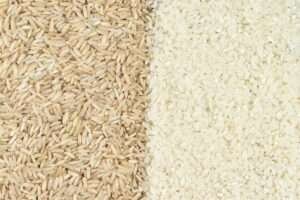A Grainy Debate: Brown Rice vs White Rice

-History of Rice
Rice is one of the oldest and most important staple crops in the world, and its history can be traced back over 5,000 years. Rice cultivation techniques and varieties have evolved over time, and today there are thousands of different types of rice grown around the world. In India, rice has been a staple food for thousands of years and is an essential part of the country’s cuisine and culture. Rice plants belong to the grass family. The grain itself is the edible seed that is produced by the plant. Rice can be processed into different forms, such as white or brown rice, black rice and they vary in terms of health benefits.
Varieties of Rice
-what is white rice
White rice is a type of rice that has had the outer layer, or hull, removed during processing. This results in a grain that is lighter in color and has a softer texture than brown rice.
– what is Brown rice
Brown rice is a type of whole grain rice that is unpolished, meaning that the outer layer, or hull, is left intact. This gives brown rice its characteristic brown color and chewy texture. Because the bran and germ layers are not removed during processing, brown rice is more nutritious than white rice.
-Nutritional profile of brown rice-
| Nutrient proximates | Brown rice | White rice |
| Energy | 82 calories | 68 calories |
| Protein | 1.83 g | 1.42 g |
| Total lipid fat | 0.65 g | 0.15 g |
| Carbohydrates | 17.05 g | 14.84 g |
| Sugars | 0.16 g | 0.03 g |
| Calcium | 2 milligrams (mg) | 5 mg |
| Iron | 0.37 mg | 0.63 mg |
| Sodium | 0.37 mg | 1 mg |
| Fatty acids, total saturated | 0.17 g | 0.04 g |
| Fatty acids, total trans | 0 g | 0 g |
| Cholesterol | 0 mg | 0 mg |
– Health benefits of brown rice
- Supports Digestive Health: Brown rice is a good source of fiber, which can help promote regular bowel movements, prevent constipation, and support overall digestive health.
- Helps Manage Blood Sugar: Brown rice has a lower glycemic index than white rice, which means it can help manage blood sugar levels and reduce the risk of developing type 2 diabetes.
- Supports Heart Health: Brown rice contains antioxidants and fiber, which can help reduce inflammation, lower cholesterol levels, and improve blood pressure, all of which contribute to a healthier heart.
- Supports Weight Management: Brown rice is a low-calorie and filling food that can help with weight management when consumed as part of a balanced diet.
- Boosts Energy Levels: Brown rice is a good source of complex carbohydrates that can provide sustained energy throughout the day.
- Provides Essential Nutrients: Brown rice is rich in essential vitamins and minerals, including B vitamins, magnesium, and selenium, all of which are important for overall health and wellness.
-Health benefits of white rice
- Provides Energy: White rice is a good source of carbohydrates, which provide energy to the body. This can be beneficial for athletes or people who engage in physical activity.
- Easy to Digest: White rice is often recommended for individuals with digestive issues or recovering from an illness because it is easy to digest and does not contain fiber that can be difficult to break down.
- Can be Enriched: White rice is often enriched with B vitamins and iron, which can help improve nutrient intake in individuals who may have deficiencies.
-Is White Rice unhealthy?
White rice is not necessarily considered unhealthy, but it is less nutritious compared to brown rice. Additionally, white rice has a higher glycemic index compared to brown rice, which can be problematic for people with diabetes or those looking to manage their blood sugar levels. While white rice can still be included in a healthy diet, it is recommended to consume a variety of whole grains, including brown rice, as part of a balanced diet for optimal health.










